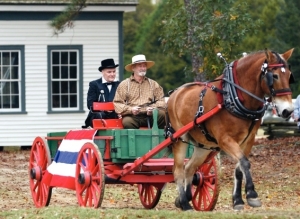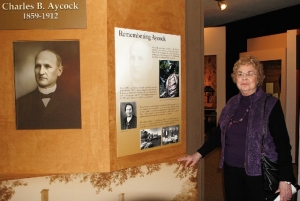Aycock Birthplace turns 50
By Steve Herring
Published in News on November 2, 2009 1:46 PM

News-Argus/STEVE HERRING
Gov. Charles B. Aycock (as portrayed by Jim McKee of Southport) rides in a horse-drawn wagon driven by Julius Rouse of Seven Springs Sunday on his way to speak at the grand reopening of his homeplace that was damaged by fire two years ago. The reopening coincided with the 50th anniversary of the Charles B. Aycock Birthplace State Historic Site at Fremont and Aycock's 150th birthday. In the background is the site's one-room schoolhouse.

News-Argus/STEVE HERRING
Jean Aycock Chase, grandniece of the late Gov. Charles B. Aycock whose photo is at left, looks at a display in the Charles B. Aycock Birthplace State Historic Site visitors' center. Her mother, Mildred Gurley Aycock, was instrumental in the early development of the site.
FREMONT -- Looking at the barn and hayloft near Charles B. Aycock's historic home, most people see a page out of the state's history. Jean Aycock Chase, however, sees herself as a young girl who accepted the dare of a cousin and sailed out the hayloft door.
Mrs. Chase, Aycock's grandniece, escaped unharmed, but never told her mother.
Sunday, Mrs. Chase, who now lives in Cary, was among the more than 150 people who gathered to celebrate Aycock's 150th birthday and the Gov. Charles B. Aycock Birthplace State Historic Site's 50th anniversary.
The dual celebration also was used to commemorate the grand reopening of the Aycock home that was damaged by fire nearly two years ago.
"When I looked at that hayloft -- it used to be in our backyard -- it has a little window or big door on the second level and that is where they put the hay," Mrs. Chase said. "Two of my cousins came out to play one time and one of them dared me to jump out of that window.
"I wanted to do it, but I didn't because I didn't know whether I could get hurt or not. I never did tell my mother that I did it, but I did jump out. I thought about that when I looked up and saw that barn."
As she walked around inside the site's visitors' center, she recalled how the land where the center sits was once a mulberry orchard.
"I think it is interesting to know that the ground we are standing on now used to be a mulberry orchard," she said. "My dad (Wiley Aycock) would bring the pigs down here when the mulberries were in season and put them in a pen and they would eat the mulberries.
"I don't know if there are any of those old trees left or not. We had white mulberries and purple mulberries. I would come down here barefooted and walk in the mulberries and go back home with purple feet. I think about little stories like that when I come through here. Of course, my grandparents, aunts and uncles are buried in the cemetery (here)."
The building behind the birthplace house once served as a smokehouse behind her nearby childhood home. When hogs were killed, the meat would be hung up in the smokehouse.
"I recognized that, too, so it takes me back a little bit because these are familiar things to me when I was growing up," she said. "We owned the adjoining land and our family gave a part of this land. I was born in the house that is within sight of the historic site. I was born and raised there."
Mrs. Aycock, who will turn 80 on Nov. 11, said she returns to the site on a regular basis and feels "very good, very proud" of her connection to the area and its history.
"It (ceremony) was fine, very nice," she said. "I saw a lot of my nieces and nephews. I am the only one of my immediate family, of my brothers and sisters, still living.
"Mother (Mildred Gurley Aycock) did a lot of work with Mr. (Richard) Sawyer from Raleigh (the site's first manager) to help find furniture for the buildings out here and help with finding the schoolhouse. So I feel like she made a contribution. They would go look at old pieces of furniture and they would talk about what they would need to refurbish."
And Sawyer has returned to the site many times over the years, as well as on Sunday.
"I did the research and supervised the rebuilding of the place," he said. "It was my first one and as I look back there are some things that I would change, but I think being new at it that I did a pretty good job.
"It is just wonderful. They brought me down to point out the lumber that was original on the house here on the back because I was the only one who knew. It was a lot of fun."
*
Planning for Sunday's event has been under way for several months site manager Leigh Strickland said.
"The house was damaged by fire on Jan. 24, 2008, so it was almost two years ago," she said. "We have been working on restoring the house since then. We finally got it rebuilt and got furniture back into it.
"We have invited Aycock family members to come help us celebrate and the general public, former employees."
Tents were set up because of the threatening rain that held off until after the ribbon-cutting ceremony to reopen the house.
Sisters Hannah and Rebecca Price of Lucama, demonstrated 19th century toys, while their brother, Josh, operated an apple press making cider. Other volunteers demonstrated open-hearth cooking, weaving and blacksmithing.
Jim McKee of Southport, who works for the state's historic sites office, impersonated Aycock, riding up on a horse-drawn wagon to a large tent set up in case of rain.
"I hope this is not all for me, a simple lawyer from Fremont" he said speaking in character. "I don't know if I can handle this. We are here for a number of reasons not so much for my birthday, but also to celebrate the founding of this site, my birthplace -- a place that is dedicated to promoting the education of our fair state something that I found very, very important.
"I look at these young folks here and hope they never have to face the devastation of a storm or early frost that destroys the crops. By educating these young folks and educating your young folks, that is going to be the power that is going to make our great state. Education is something that you can't take away from anybody."
Keith Hardison, director, the N.C. Division of State Historic Sites and Properties, spoke briefly about Aycock and his legacy.
He said that Aycock's interest in education was born while watching his mother sign a deed with her "mark."
"He has been called first progressive governor of the state, and in many regards lived up to that title," Hardison said. "Nevertheless in his views of African-Americans and segregation, rather than being progressive, he was clearly a man of the old order; a man of his times and a staunch defender of the status quo.
"Charles B. Aycock was an important historical figure. Like other such figures he left a legacy. Not surprisingly for a public, but human public servant, his legacy is mixed."
The positive aspect is the one embraced in recent years, he said. Aycock supported higher teacher salaries, longer school terms and pushed statewide adoption of textbooks, he said.
"To say building of new schools was a priority for him is an understatement," Hardison said. "During his administration more than 1,000 new public schools were erected, an average of more than one a day for both black and white students."
In addition, 877 libraries were added to rural schools.
George Holding, United States attorney for the Eastern District of N.C. -- an office Aycock was once appointed to by President Grover Cleveland -- led a discussion of the office and how it has changed.
Also held was a program on the legacy of segregated education and the Charles B. Aycock High School band performed.
The site is open November through March, Tuesday through Saturday from 9 a.m. to 5 p.m., and April through October, Monday through Saturday, 9 a.m. to 5 p.m.
Christmas candlelight tours will be held Dec. 1 and 3 from 6:30 to 9 p.m.
